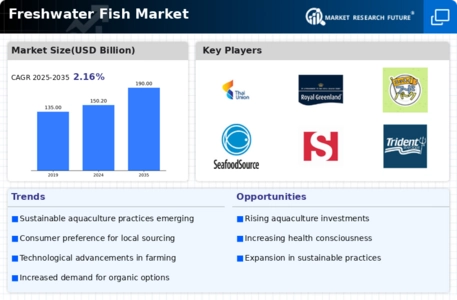Increased Focus on Sustainability
Sustainability is becoming a central theme within the Freshwater Fish Market, as consumers and producers alike prioritize environmentally responsible practices. The demand for sustainably sourced fish is on the rise, with consumers increasingly seeking certifications that indicate responsible farming practices. This trend is reflected in market data, which shows that sales of certified sustainable seafood have grown by approximately 25% in the last three years. Producers are responding by adopting practices that minimize environmental impact, such as integrated multi-trophic aquaculture, which promotes biodiversity and resource efficiency. This increased focus on sustainability is likely to shape the future of the Freshwater Fish Market, as it aligns with consumer values and regulatory expectations.
Expansion of Distribution Channels
The Freshwater Fish Market is witnessing an expansion of distribution channels, which is facilitating greater access to freshwater fish products. Retailers are increasingly diversifying their offerings by including fresh, frozen, and processed fish in their inventory. E-commerce platforms are also emerging as significant players, allowing consumers to purchase fish directly from producers. This shift is supported by market data indicating that online sales of seafood have surged by over 20% in recent years. As distribution channels continue to evolve, they are likely to enhance the visibility and availability of freshwater fish, thereby stimulating demand and contributing to the overall growth of the Freshwater Fish Market.
Technological Advancements in Aquaculture
Technological innovations are playing a pivotal role in shaping the Freshwater Fish Market. Advances in aquaculture technology, such as recirculating aquaculture systems and automated feeding systems, are enhancing production efficiency and sustainability. These technologies not only improve fish growth rates but also reduce the environmental impact of fish farming. For instance, the implementation of biofloc technology has been shown to increase yields by up to 30% while minimizing water usage. As these technologies become more widely adopted, they are expected to drive growth in the Freshwater Fish Market, enabling producers to meet the increasing demand for high-quality fish products while maintaining ecological balance.
Rising Consumer Demand for Freshwater Fish
The Freshwater Fish Market is experiencing a notable increase in consumer demand, driven by a growing awareness of the health benefits associated with fish consumption. As consumers become more health-conscious, they are increasingly seeking protein sources that are low in fat and high in omega-3 fatty acids. This trend is reflected in market data, which indicates that the consumption of freshwater fish has risen by approximately 15% over the past five years. Additionally, the shift towards more sustainable and environmentally friendly food sources is influencing purchasing decisions, as consumers prefer fish that are sourced from responsible aquaculture practices. This rising demand is likely to propel the Freshwater Fish Market forward, as producers adapt to meet the evolving preferences of health-oriented consumers.
Culinary Trends Influencing Freshwater Fish Consumption
Culinary trends are significantly influencing the Freshwater Fish Market, as chefs and home cooks alike explore diverse ways to prepare and present fish dishes. The rise of global cuisine has led to an increased interest in various freshwater fish species, which are being incorporated into traditional and contemporary recipes. Market data suggests that the popularity of freshwater fish in gourmet cooking has contributed to a 10% increase in sales over the past year. Additionally, the growing trend of plant-based diets is prompting chefs to create innovative dishes that feature freshwater fish as a complement to plant-based ingredients. This culinary evolution is likely to enhance the appeal of freshwater fish, driving further growth in the Freshwater Fish Market.


















Leave a Comment